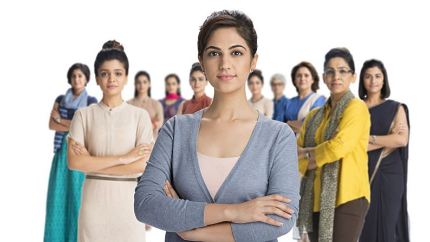Feature
Women Empowerment – more needs to be done

Women empowerment is often misunderstood by people of this era. There are certain arguments that women have progressed when talking of empowerment. However, there is still a road ahead and there is still much scope for improvement. The true meaning of women empowerment is portrayed by some amazing women who make their life an example and make their parents proud of themselves. Women’s empowerment and promoting women’s rights have emerged as a part of a major global movement and are continuing to break new ground in recent years.
When women are living safe, fulfilled, and productive lives, they can reach their full potential. Contributing their skills to the workforce and can raise happier and healthier children. They are also able to help fuel sustainable economies and benefit societies and humanity at large.
Women in India are emerging in all sectors, including politics, business, medicine, sports, and agriculture. History was made when two female scientists from the Indian Space Research Organisation led the country’s second lunar mission Chandrayaan-2 from its inception to completion in 2019. Female leadership for a huge space mission challenged the meta-narrative that rocket science is a profession reserved for men.
India’s story on women empowerment is not complete without focusing on grassroots initiatives adopted by the government and civil society organizations. The federal and state governments have launched new schemes, policies, and programs to empower both urban and rural women. The Narendra Modi government has launched flagship schemes to promote gender equality, including Beti Bachao Beti Padhao, Pradhan Mantri Ujjwala Yojana (a scheme to provide gas connections to women from below the poverty line households), and Mahila-E-Haat. The Bachao Beti Padhao Yojana scheme was launched in January 2015 to address the issue of a gender skewed ratio and generate greater welfare for the girl child. The focus is centered mostly on Northern India, including Haryana, Uttar Pradesh, Delhi, Punjab, and Uttarakhand where the gender ratio is wider. The Mahila-E-Haat project, an online marketing campaign, was launched in 2016.
India has managed to close two-thirds of its overall gender gap, especially in areas of political empowerment. It was ranked 18th on the Political Empowerment sub-index, given that a woman headed the government for 20 years. However, female legislators constitute only 14.4 percent of the Indian parliament and 23 percent of the cabinet, making overall political representation relatively low. Unfortunately, its performance on economic empowerment for women has widened since 2006.
A more concerted effort is needed to close the urban-rural divide and ensure that women in rural areas enjoy the same access to education, employment, healthcare, and decision-making as their urban counterparts. The hardest challenge will be to change attitudes, given that many barriers to women empowerment are attributed to patriarchal and patrilineal traditions that are deeply entrenched in many South Asian societies.
The Indian legal system is also confronted with gaps between policy and practice. Despite existing legislation to protect women and girls, the enforcement of these laws and the conviction of alleged perpetrators are weak. The gaps in these processes are widened by systemic bureaucracy and corruption. It took seven years to hang the perpetrators implicated in the notorious “Nirbhaya” gang-rape case. There is also the issue of women empowerment being less visible in rural India than in urban settings. This should be a big concern in India, given that the rural population is around 65.97 percent despite increasing urbanization and the growth of cities.
Empowering women is essential to the health and social development of families, communities, and countries. For sustainable development, nations must take note of critical problems that run deep in our society such as women’s economic empowerment and gender equality. Create high-level corporate leadership for gender equality. Promote education, training, and professional development for women. There is a need to empower and encourage women for a better tomorrow.
Entertainment
Meghalaya Reserves Legalized Gambling and Sports Betting for Tourists

The State Scores Extra High on Gaming-Friendly Industry Index
Meghalaya scored 92.85 out of 100 possible points in a Gaming Industry Index and proved to be India’s most gaming-friendly state following its recent profound legislation changes over the field allowing land-based and online gaming, including games of chance, under a licensing regime.
The index by the UK India Business Council (UKIBC) uses a scale of 0 to 100 to measure the level of legalisation on gambling and betting achieved by a state based on the scores over a set of seven different games – lottery, horse racing, betting on sports, poker, rummy, casino and fantasy sports
Starting from February last year, Meghalaya became the third state in India’s northeast to legalise gambling and betting after Sikkim and Nagaland. After consultations with the UKIBC, the state proceeded with the adoption of the Meghalaya Regulation of Gaming Act, 2021 and the nullification of the Meghalaya Prevention of Gambling Act, 1970. Subsequently in December, the Meghalaya Regulation of Gaming Rules, 2021 were notified and came into force.
All for the Tourists
The move to legalise and license various forms of offline and online betting and gambling in Meghalaya is aimed at boosting tourism and creating jobs, and altogether raising taxation revenues for the northeastern state. At the same time, the opportunities to bet and gamble legally will be reserved only for tourists and visitors.
“We came out with a Gaming Act and subsequently framed the Regulation of Gaming Rules, 2021. The government will accordingly issue licenses to operate games of skill and chance, both online and offline,” said James P. K. Sangma, Meghalaya State Law and Taxation Minister speaking in the capital city of Shillong. “But the legalized gambling and gaming will only be for tourists and not residents of Meghalaya,” he continued.
To be allowed to play, tourists and people visiting the state for work or business purposes will have to prove their non-resident status by presenting appropriate documents, in a process similar to a bank KYC (Know Your Customer) procedure.
Meghalaya Reaches Out to a Vast Market
With 140 millions of people in India estimated to bet regularly on sports, and a total of 370 million desi bettors around prominent sporting events, as per data from one of the latest reports by Esse N Videri, Meghalaya is set to reach out and take a piece of a vast market.
Estimates on the financial value of India’s sports betting market, combined across all types of offline channels and online sports and cricket predictions and betting platforms, speak about amounts between $130 and $150 billion (roughly between ₹9.7 and ₹11.5 lakh crore).
Andhra Pradesh, Telangana and Delhi are shown to deliver the highest number of bettors and Meghalaya can count on substantial tourists flow from their betting circles. The sports betting communities of Karnataka, Maharashtra, Uttar Pradesh and Haryana are also not to be underestimated.
Among the sports, cricket is most popular, registering 68 percent of the total bet count analyzed by Esse N Videri. Football takes second position with 11 percent of the bets, followed by betting on FIFA at 7 percent and on eCricket at 5 percent. The last position in the Top 5 of popular sports for betting in India is taken by tennis with 3 percent of the bet count.
Local Citizens will Still have Their Teer Betting
Meghalaya residents will still be permitted to participate in teer betting over arrow-shooting results. Teer is a traditional method of gambling, somewhat similar to a lottery draw, and held under the rules of the Meghalaya Regulation of the Game of Arrow Shooting and the Sale of Teer Tickets Act, 2018.
Teer includes bettors wagering on the number of arrows that reach the target which is placed about 50 meters away from a team of 20 archers positioned in a semicircle.
The archers shoot volleys of arrows at the target for ten minutes, and players place their bets choosing a number between 0 and 99 trying to guess the last two digits of the number of arrows that successfully pierce the target.
If, for example, the number of hits is 256, anyone who has bet on 56 wins an amount eight times bigger than their wager.























